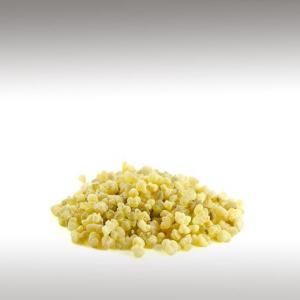
FRANKINCENSE ESSENTIAL OIL (BOSWELLIA CARTERII) - ESSENTIAL OILS

BASE / GENERAL DATA
Information submited: March 26, 2015 Modified: March 12, 2018 By: OperaDreamhouse
Botanical Name: Boswellia carterii
Common Method of Extraction: Steam distilled
Part Typically Used: Resin
Color: Light Yellow
Consistency: Thin
Perfumery Note: Base
Strength of Initial Aroma: Fresh, woody, spicy, balsamic with a citrus top note.
Frankincense, also called Olibanum, Levonah, Luban and Khunk, is an aromatic, congealed, resinous sap from a specific variety of trees in the genus Boswellia of the family Burseraceae.
Frankincense trees grow in regions of the world that are extremely dry and experience intense sunlight. Frankincense is harvested from Somalia or Oman.
The trees require an arid climate where moisture is provided by morning mist. The few ideal environments in the world for this small prized tree are found in Southern Arabia (Oman and Yemen), India, and Northern Africa (Somalia, Ethiopia, Eritrea and Kenya). Further, Frankincense trees require a limestone-rich soil and are mostly found growing on rocky hillsides and cliffs, or in the dried river beds below.
It originates from the Middle East, with abundant pinnacle leaves and has white or pale pink flowers. Deep incisions are made in the tree trunk and the bark peels off in narrow strips. Over weeks a milky juice exudes and hardens on contact with the air, resulting in an oleo gum resin, from which the oil is extracted by steam distillation.
The resin comes from inside the tree, under the bark. To collect Frankincense properly, a slow and carefully executed process must be followed. The process can only take place twice a year - once in the spring (March to May) and then again in the fall (September to October) and takes two weeks.
After all the process the crystalresin goes into the distillery where it is crushed into powder, put into an oil bath, and steam distilled to extract the oil from the crystal resin.
Frankincense quality is based on color, purity, aroma, age, and in some cases, where it is grown affects the quality. The first grade of Frankincense resin is the most common. It is a brownish resin that has a great deal of bark particles in it.
The resins such as Frankincense are known as sacred substances among many ancient and modern cultures. Boswellia Carterii the most typical and common Frankincense aroma, with a moderately strong terpenic top note and lovely pine heart notes.
One of the primary Frankincense varieties, Frankincense Carterii represents a fine balance of pleasing, fragrance sweetness and an important therapeutic profile. Frankincense essential oil smells sweeter, cleaner and fresher than the resin.
According to the latest scientific opinion both Boswellia Sacra and Boswellia Carteri are the same and should be correctly called Boswellia Sacra. Boswellia Sacra, produces the highest grade of Frankincense.
The tradition of caretaking Frankincense trees and harvesting their resin have played an important role in the life of nomadic desert tribes in North Africa for millennia. The trees are owned by families living in the area where they grow; ancient rituals surround the harvesting of the resin and the guardianship of the trees, which are passed on from generation to generation. Unfortunately, the traditions, customs and ceremonies surrounding Frankincense, like many other important plants, are being lost: as people embrace modern lifestyles, the old ways of caring for plants vanishes, and the plant's numerous benefits are lost.
Chemical structure:
This same complexity carries over to the chemical composition of the oil, which has over 200 individual natural chemicals that endow it with a complex aromatic bouquet and therapeutic profile. There is considerable variation in the proportion of these components depending on the micro-climate where the trees grow, the season at which the resin is harvested, and a number of other factors.
The gum resin of Frankincense contains Boswellic acids and other pentacyclic triterpens, which have a chemical structure that closely resembels that of steroids.
Common Method of Extraction: Steam distilled
Part Typically Used: Resin
Color: Light Yellow
Consistency: Thin
Perfumery Note: Base
Strength of Initial Aroma: Fresh, woody, spicy, balsamic with a citrus top note.
Frankincense, also called Olibanum, Levonah, Luban and Khunk, is an aromatic, congealed, resinous sap from a specific variety of trees in the genus Boswellia of the family Burseraceae.
Frankincense trees grow in regions of the world that are extremely dry and experience intense sunlight. Frankincense is harvested from Somalia or Oman.
The trees require an arid climate where moisture is provided by morning mist. The few ideal environments in the world for this small prized tree are found in Southern Arabia (Oman and Yemen), India, and Northern Africa (Somalia, Ethiopia, Eritrea and Kenya). Further, Frankincense trees require a limestone-rich soil and are mostly found growing on rocky hillsides and cliffs, or in the dried river beds below.
It originates from the Middle East, with abundant pinnacle leaves and has white or pale pink flowers. Deep incisions are made in the tree trunk and the bark peels off in narrow strips. Over weeks a milky juice exudes and hardens on contact with the air, resulting in an oleo gum resin, from which the oil is extracted by steam distillation.
The resin comes from inside the tree, under the bark. To collect Frankincense properly, a slow and carefully executed process must be followed. The process can only take place twice a year - once in the spring (March to May) and then again in the fall (September to October) and takes two weeks.
After all the process the crystalresin goes into the distillery where it is crushed into powder, put into an oil bath, and steam distilled to extract the oil from the crystal resin.
Frankincense quality is based on color, purity, aroma, age, and in some cases, where it is grown affects the quality. The first grade of Frankincense resin is the most common. It is a brownish resin that has a great deal of bark particles in it.
The resins such as Frankincense are known as sacred substances among many ancient and modern cultures. Boswellia Carterii the most typical and common Frankincense aroma, with a moderately strong terpenic top note and lovely pine heart notes.
One of the primary Frankincense varieties, Frankincense Carterii represents a fine balance of pleasing, fragrance sweetness and an important therapeutic profile. Frankincense essential oil smells sweeter, cleaner and fresher than the resin.
According to the latest scientific opinion both Boswellia Sacra and Boswellia Carteri are the same and should be correctly called Boswellia Sacra. Boswellia Sacra, produces the highest grade of Frankincense.
The tradition of caretaking Frankincense trees and harvesting their resin have played an important role in the life of nomadic desert tribes in North Africa for millennia. The trees are owned by families living in the area where they grow; ancient rituals surround the harvesting of the resin and the guardianship of the trees, which are passed on from generation to generation. Unfortunately, the traditions, customs and ceremonies surrounding Frankincense, like many other important plants, are being lost: as people embrace modern lifestyles, the old ways of caring for plants vanishes, and the plant's numerous benefits are lost.
Chemical structure:
This same complexity carries over to the chemical composition of the oil, which has over 200 individual natural chemicals that endow it with a complex aromatic bouquet and therapeutic profile. There is considerable variation in the proportion of these components depending on the micro-climate where the trees grow, the season at which the resin is harvested, and a number of other factors.
The gum resin of Frankincense contains Boswellic acids and other pentacyclic triterpens, which have a chemical structure that closely resembels that of steroids.

SPIRITUAL PRACTISES DATA

MEDICINE / HEALTH DATA

BEAUTY / COSMETICS DATA

FOOD / COOKING DATA
COMMENTS
No comments.
Newest mixtures containing Frankincense Essential Oil (Boswellia Carterii):

Full body deodorant (sweat odor eliminator)
August 6, 2015

Summer time body moisturizer
August 5, 2015


